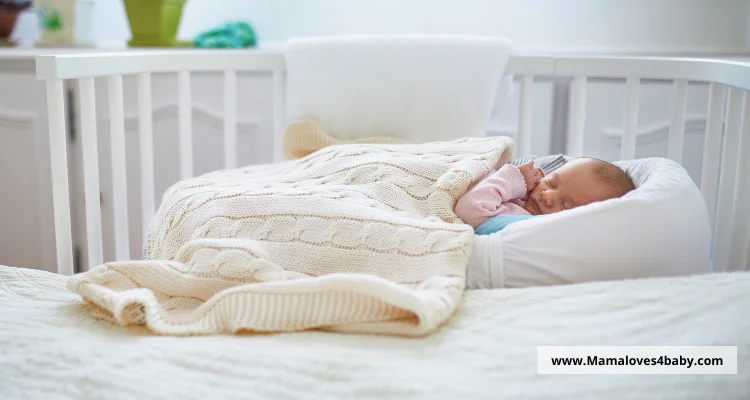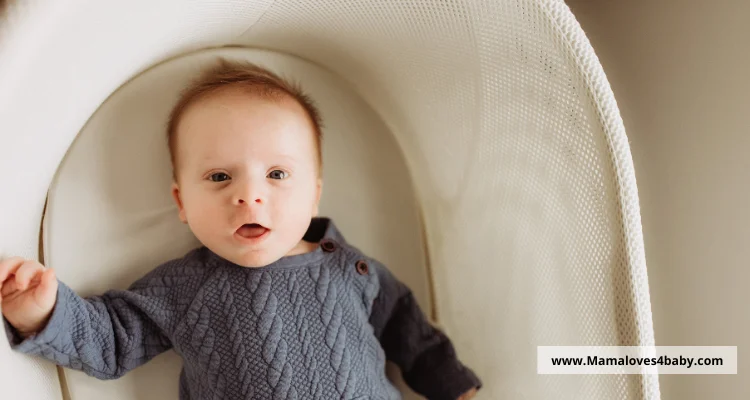Bassinets are an excellent option for newborns because they provide a safe, comfortable place for your baby to sleep. But how long do babies sleep in bassinet?and when is baby too big for bassinet?

AAP recommends room sharing for at least six months, but only sometimes. A bedside sleeper is a convenient way to do this because it gives them comfort and access when they need both during nighttime hours without having too far walk down cold hallways after lights out (or before).
How long does a baby sleep in a bassinet?
Experts recommend that babies spend their first four to six months in a bassinet. After that, they can transition to a crib.
A quick guide to how long do babies sleep in bassinet
how long can a baby sleep in a co sleeper bassinet? when your baby
- is sleeping through the night without waking up.
- Is comfortable with a baby monitor
- And can sleep in a bassinet for at least six hours.
- Baby’s weight is growing steadily.
- Can turn over and sit up on their own.
- Can crawl or walk.
- Is teething.
- Is starting to eat solid foods.
- Has set bedtime routine
- Is no longer using a pacifier.
- Has outgrown the bassinet.
How long are bassinets good for?
A bassinet is one of the best places to put your baby to sleep in those first few months. They’re small and lightweight so that you can carry them from your own room to the baby’s room, and they often come with handy extras like mosquito nets and storage baskets. But how long should you use a bassinet for? When is it time to move your baby into a cot?
Many parents wonder how long can a baby stay in a bassinet as every newborn baby is different. A baby’s movement in a sleep sack may be content in a bassinet for a few hours, while others may need to be moved to a crib after just a short period.
If your baby seems happy and comfortable in the bassinet, there is no need to worry about moving them to a crib other than the parent’s room. However, it may be time to switch if you notice your baby is fussier or uncomfortable.
How Long are babies in bassinet?
Bassinets are designed for infants around four or five months old or when they start to roll over, whichever comes first. Once babies can roll over, they might be able to get into a position where they could fall out of the bassinet.
If you’re using a bassinet with lower sides, it’s also important to remember that once your baby can sit up unassisted, they might be able to lower the side and get out that way.
Most bassinets will have a maximum weight limit of around 15 pounds (7 kilograms). So if your baby approaches this weight, it’s time to start thinking about transitioning them into a cot.
If you have a particularly active sleeper, they might start to outgrow their bassinet sooner than average. It is because they might start bouncing and shaking the bassinet, potentially leading to an accident due to an uncomfortable position while sleeping.
Safe sleep guidelines for how long can baby sleep in bassinet if rolling over.
It depends on various factors, including the baby’s sleep needs and habits. However, most experts agree that it is generally safe for babies to sleep in bassinets for short periods, provided they are supervised.
Babies under four months of age should be kept in a bassinet they are more at risk of Sudden Infant Death Syndrome (SIDS) any time they choose.

If you need to leave your baby unattended, put them in a safe sleep space that meets current safety standards, such as a crib or play yard.
To find out how long are bassinets good for? It is also essential to ensure that the bassinet is in good condition and well-maintained, as older bassinets may need to meet current safety standards. Therefore, always check your bassinet is certified by the Juvenile Products Manufacturers Association (JPMA). This certification means that the bassinet meets all safety standards of the Consumer Product Safety Commission (CPSC).
Additionally, babies should never be placed to sleep on their stomachs or with loose blankets and pillows in the bassinet, as this can enhance the risk of SIDS. For these reasons, it is generally best to transition a baby from the bassinet to a crib after they reach four months of age.
10 Physical developmental milestones that determine how long does a baby sleep in a bassinet
Baby sleep patterns
| When the baby is born | they can sleep up to 4 hours in their bassinet in the same room. |
| Reach 2 months | At 2 months old, your baby may be able to sleep up to 8 hours. |
| Reach 4 months | By 4 months old, your baby may be able to sleep up to 8 hours in the bassinet. |
| Reach 6 months | Now your baby should be able to sleep up to 10 hours. |
when can baby sleep in crib overnight? Babies should be repositioned in the bassinet every two hours until they are 6 months old. However, when transition baby, they should be able to take night sleep for at least 8 hours without needing to be repositioned. Once your baby achieves this night sleep milestone, you can move them to a crib full-time.
Baby can roll over
Baby’s first rolling over milestone usually occurs around the four- to the five-month mark. Rolling over is an exciting milestone, as it’s the first time your baby has actively used their muscles to move around. Your child may take a few tries to master rolling over, so be patient and encouraging.
Baby can sit up and must sleep in a crib or play yard.
As your baby grows, it may be time to transition them from the safety of their bassinet or cradle into a crib. A crib provides a safe and comfortable newborn sleep and is designed to accommodate their size and growing mobility.
Once your baby can sit up, you should no longer use a bassinet or cradle, as the sides and walls of these pieces of furniture do not prevent your baby from attempting to roll out.
Baby can pull up to stand.
When your child starts to pull up and stand, it’s time for them to transition to a toddler bed. This type of bed is smaller than a twin or full-size bed but larger than a crib and provides enough space for your toddler to stretch out.
It’s also designed with safety features such as low side rails that prevent your child from falling out. Ensure that you use a mattress and bedding set made explicitly for toddler beds, as these are designed to fit safely in the bed and prevent suffocation or entrapment hazards.
Additionally, ensure to anchor the bed so it won’t tip over if your child attempts to climb out of it. Properly securing the bed will keep your child safe and give you peace of mind.
Baby sleeping habits
How long can babies sleep in bassinet also depends on baby’s sleeping habits. You’ll want to consider your baby’s sleeping habits. A bassinet may be better for a light-sleeper baby who wakes up frequently than a crib. It is because bassinets usually have softer sides and are more enclosed, which can help your baby feel snug and secure.
Need for a standalone bassinet
Parents must decide whether they want a standalone bassinet or one that attaches to their bed. Standalone bassinets are great because you can move them around the house, but they’re less convenient than attached bassinets if you are a breastfeeding mother and need to feed in the middle of the night to feed or console your baby.
Your baby reaches 20 pounds.
At this point, your baby is likely getting too big and active for a bassinet. However, you can keep a baby in the bassinet until they reach 20 pounds or roll over independently, whichever comes first.
To ensure your baby’s safety, check the manufacturer’s specifications for the weight and size limits of the bassinet. It is important to note that bassinets are not recommended for babies who can pull themselves up or climb out.
Baby can sleep for up to 8 hours without needing to be repositioned.
Once your baby can sleep for up to 8 hours without needing to be repositioned, it’s time to move them into a crib. A crib provides more space and support for your baby to move around and stretch out without needing to be repositioned.
Additionally, the crib’s sides provide a safe barrier that prevents your baby from attempting to climb out. Make sure to use a mattress and bedding explicitly set for the size and shape of your crib to prevent suffocation or entrapment hazards.
Baby can climb out of the bassinet.
If your baby has begun to climb out of the bassinet, it’s time for them to move into a bed or play yard. Bed rails provide a safe barrier to prevent your baby from attempting to climb out and are available in twin or full sizes. Play yards also provide a safe sleep space but are not recommended for babies who can climb out of the bassinet.
Baby has outgrown the bassinet age limit.
Once your baby outgrows their bassinet size limits, it’s time to transition them from a bassinet to a crib. It can be an exciting time for both parents and babies as they explore the larger space of their new bed. When the baby’s feet reach the edge of the bassinet while lying down, indicating it is time for them to move into a bigger sleeping space.
A new crib fits in your room.
The crib fits within the size limitations of your room. Measure each side of the bed before buying a crib, ensuring plenty of space on either side and above it for your baby’s safety. Also, measure the height of your baby’s mattress after placing it in the crib to ensure a safe sleeping environment for your baby.
Next, you’ll want to ensure the mattress size will fit your crib frame. Depending on the type of mattress you purchase, you may need to get an adapter kit. Also, ensure that you use a firm mattress that fits snugly in the crib frame.
Finally, test out the bedding and bumper pads you plan to use. Please ensure the bumper pads are thick enough to keep your little one from getting their arms or legs stuck between the crib bars. Also, choose warm and breathable bedding, such as all-cotton sheets.
Conclusion: how long should baby sleep in your room
So, how long do babies sleep in a bassinet? For most babies, the answer is four to six months. However, you should keep a few things in mind when making this decision, such as your baby’s sleeping habits and whether you want a standalone or attached bassinet.
It is essential to monitor your baby’s milestones when sleeping in a bassinet and move them into a bigger sleeping space as soon as it is safe. You can use a baby monitor to help ensure your child sleeps peacefully and avoids potential suffocation hazards. Additionally, always follow manufacturer guidelines for bassinets’ age, weight, and size limits. Doing so can help keep your baby safe.
Creating a comfortable, safe sleeping environment for your little one is essential. Following the guidelines and milestones outlined above can help ensure your baby’s safety and well-being while they sleep in their bedside sleepers.


